Na-Z-L-lysine thiobenzyl ester hydrochloride is widely utilized in research focused on:
- Peptide Synthesis: This compound serves as a valuable building block in the synthesis of peptides, particularly in the development of therapeutic agents. Its unique structure allows for the incorporation of specific amino acids, enhancing the efficacy of peptide-based drugs.
- Drug Development: It plays a crucial role in medicinal chemistry, where it is used to modify drug candidates to improve their pharmacological properties, such as solubility and bioavailability, making them more effective in clinical applications.
- Bioconjugation: The compound is employed in bioconjugation processes, linking biomolecules to therapeutic agents. This application is essential in creating targeted drug delivery systems, which can enhance treatment precision in diseases like cancer.
- Research in Protein Engineering: Researchers utilize this chemical in protein engineering studies to modify lysine residues, facilitating the development of proteins with enhanced stability and activity, which is vital for various biotechnological applications.
- Analytical Chemistry: It is used as a reagent in analytical chemistry for the detection and quantification of amino acids and peptides, providing researchers with reliable methods for characterizing complex biological samples.
General Information
Properties
Safety and Regulations
Applications
Na-Z-L-lysine thiobenzyl ester hydrochloride is widely utilized in research focused on:
- Peptide Synthesis: This compound serves as a valuable building block in the synthesis of peptides, particularly in the development of therapeutic agents. Its unique structure allows for the incorporation of specific amino acids, enhancing the efficacy of peptide-based drugs.
- Drug Development: It plays a crucial role in medicinal chemistry, where it is used to modify drug candidates to improve their pharmacological properties, such as solubility and bioavailability, making them more effective in clinical applications.
- Bioconjugation: The compound is employed in bioconjugation processes, linking biomolecules to therapeutic agents. This application is essential in creating targeted drug delivery systems, which can enhance treatment precision in diseases like cancer.
- Research in Protein Engineering: Researchers utilize this chemical in protein engineering studies to modify lysine residues, facilitating the development of proteins with enhanced stability and activity, which is vital for various biotechnological applications.
- Analytical Chemistry: It is used as a reagent in analytical chemistry for the detection and quantification of amino acids and peptides, providing researchers with reliable methods for characterizing complex biological samples.
Documents
Safety Data Sheets (SDS)
The SDS provides comprehensive safety information on handling, storage, and disposal of the product.
Product Specification (PS)
The PS provides a comprehensive breakdown of the product’s properties, including chemical composition, physical state, purity, and storage requirements. It also details acceptable quality ranges and the product's intended applications.
Certificates of Analysis (COA)
Search for Certificates of Analysis (COA) by entering the products Lot Number. Lot and Batch Numbers can be found on a product’s label following the words ‘Lot’ or ‘Batch’.
*Catalog Number
*Lot Number
Certificates Of Origin (COO)
This COO confirms the country where the product was manufactured, and also details the materials and components used in it and whether it is derived from natural, synthetic, or other specific sources. This certificate may be required for customs, trade, and regulatory compliance.
*Catalog Number
*Lot Number
Safety Data Sheets (SDS)
The SDS provides comprehensive safety information on handling, storage, and disposal of the product.
DownloadProduct Specification (PS)
The PS provides a comprehensive breakdown of the product’s properties, including chemical composition, physical state, purity, and storage requirements. It also details acceptable quality ranges and the product's intended applications.
DownloadCertificates of Analysis (COA)
Search for Certificates of Analysis (COA) by entering the products Lot Number. Lot and Batch Numbers can be found on a product’s label following the words ‘Lot’ or ‘Batch’.
*Catalog Number
*Lot Number
Certificates Of Origin (COO)
This COO confirms the country where the product was manufactured, and also details the materials and components used in it and whether it is derived from natural, synthetic, or other specific sources. This certificate may be required for customs, trade, and regulatory compliance.


